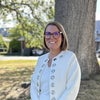Bringing women on board
Report says men still dominate directorships
A new report by a Boston-based women’s organization says the state’s corporate boards are overwhelmingly comprised of men, a trend long-prevalent in corporate culture and one that at least two local groups are trying to change.
Where are all the women?Highlights from The Boston Club’s annual census |
• Climbing the Ladder: Women hold 10.8% (91) of the 844 board seats of the 100 largest public companies in MA. That’s on the upswing from the 9.9% in 2005 and only 9.0% in 2003. Forty-three of the 100 companies have no women directors.
• Minority Report: Just 1.1% of the board seats of the 100 largest public companies in MA are filled by women of color, a number that’s been at a standstill for the last two years.
• Bigger firm, bigger chances: Larger companies, on average, have a greater percentage of women board members than smaller companies. For example, 18 of the 25 Massachusetts companies with revenues exceeding $1 billion have at least one woman director, compared with only 17 of the 43 companies with revenues below $500 million who have at least one woman director.
• Industry Matters: The Consumer Goods sector has had the highest percentage (12.8%) of women directors for the past two years. Healthcare services have had the lowest percentage (9.1%) for the last year.
• Number of women execs lags: Women account for 11 percent (78) of the 710 executive officers of the 100 largest public companies in the state, up from 10.1% in 2005 and 9.2% in both 2004 and 2003.
– A.E.C.
There are a number of efforts to stem that trend.
Report: Boards still ole boys’ clubs
The difficulties facing women trying to reach the corporate peak are well-documented, and the new Boston Club report quantifies some of those difficulties.
According to the report, 43 of the state’s largest 100 companies lack a female board member. Only 1 percent of seats at those companies are held by women of color. The trend is echoed on the executive side, where women held only 11 percent of the 710 executive officer positions at the state’s 100 largest firms.
There are some Central Mass. bright spots on that list. Natick-based Boston Scientific has four women directors. The TJX Cos. Inc. in Framingham has three. Waters Corp. in Milford, Staples Inc. in Framingham, and Cytyc Corp. in Marlboro each have two.
Farther down the ladder, 3Com Corp in Marlboro, BJ’s Wholesale Club in Natick, EMC Corp. in Hopkinton, and Hanover Insurance Group Inc. in Worcester all made the list for having only one woman director.
A number of local companies also made the list for having no female directors, including Cognex Corp. in Natick, The Commerce Group Inc. in Webster, L.S. Starrett Co. in Athol, Sepracor Inc. in Marlboro, and Perini Corp. in Framingham.
"Women who are on these boards need to be strategic about helping other women," says Wolfman. "It’s very difficult to break into that network of people."
New federal rules requiring the independence of directors may mean women have a better chance of quickly making on boards, says Andrea Teichman, a Boston lawyer and current chair of The Boston Club’s Corporate Board Resource Committee. That can open up opportunities for women to get a better foothold.
Andrea Teichman, a partner at Boston law firm Day, Berry, and Howard and Boston Club member, says that recent legal requirements for more independent and experienced directors might open up opportunities for women as directors - particularly those with executive-level experience in finance or human resources.Local groups offer mentoring, community
Of course, one way to widen that foothold is to teach women leadership skills and create communities where those skills can be sharpened. And a number of local efforts are underway to do just that.
| Ins and outs of online networking for women "It’s an attitude, not a location," says Diane Danielson, founder and CEO of the Downtown Women’s Club. The for-profit company specializes in helping businesswomen from Worcester to Boston to San Francisco learn how to network. Its newest method? DWC Faces, an internet service that allows women to meet-up online as well as advertise their businesses. |
Danielson says networking websites such as DWC Faces are the wave of the future - particularly with so many working mothers in the field - and the technology could make a helping women gain equal footing with men in the workplace.
As with any new trend, there are ins and outs. Here are the biggest, according to Danielson’s firm.
IN
• "Clicks & Mix"
Networking websites like downtownwomenslub.com allow members to make contacts online, easing busy schedules since members can make contacts anytime, from the comfort of home - even in their pajamas.
• Boosting your Googlism
Who wants to be anonymous? Online networking lets you stand out in the crowd by controlling and managing your own image and making it easier for clients and contacts to find you.
• CLC’s (Coffee, Lunch & Cocktails)
The fast pace of life today means you need to learn to network while socializing. Take advantage of ‘on the fly’ opportunities. DWC offers fun, quick events like martini and chocolate-tastings to make networking not feel like a chore.
OUT
• "Working the Room"
In the digital age, in-person meetings reinforce contacts made online. Working mothers often lack flexibility in their schedules for traditional networking groups. For those that work in home offices, the chance to make new contacts can be especially useful.
• Ms. Anonymous
Say goodbye to the days of online anonymity. Business cards get lost, names forgotten; if clients can’t reach you, they can’t work with you.
• Formal Sit-Down’s
You don’t need an evening of dinner and dancing to make a connection. Formal events can be stuffy and make some uncomfortable. Plus, they can be difficult to coordinate and costly.
"My hope is that this will become and international organization that can offer leadership and mentoring for women at all levels of their professional lives, from high school to the top of the corporate ladder," says Deborah Penta, of her new nonprofit, the Female Leadership Interest Council, or FLIC.She started the groundwork for the group back in February and is now in the process of finding advisers and members. She expects to have the group’s inaugural conference in Worcester this coming April, which will feature a very prominent, yet-unnamed speaker.
Penta envisions the group spreading through the creation of chapters in different geographies, and she already has interest in doing so from as far away places as Holland and Moldova.
The goal is to bring in trailblazing women who can teach other women how to be trailblazers, she says.
Another effort underway locally has been the growth of the Worcester chapter of the Downtown Women’s Club, a for-profit business built around the idea of creating a network of women who can function as a good ole girls’ club for each other.
"I wanted it to be a way for women to get support," says Diane Danielson, who founded the company in 1998. It now has 10,000 members.
The two-year-old Worcester chapter has about 330 members, says Susan Sullivan, a Worcester-area marketing consultant who founded the local chapter after attending similar meetings in Metrowest.
The club has helped her meet up with other local businesswomen at its monthly meetings. "What makes the club different is that the goal of their events is to attract quality versus quantity in terms of the people who come," she says.
Vanessa Epro, another member, says that she was attracted to the club’s relaxed atmosphere and the opportunity to meet new people. Since joining this past summer, Epro, a professional organizer who works out of her home says, "My name is out there a lot more than it would have been if I had just sat home doing nothing."
Now the DWC has taken to the Internet, trying to create something like a MySpace.com for the modern businesswoman. That online network, called DW Faces, functions as both a networking tool for members to keep track of each other doubling as a publicity tool that allows members to create websites for attracting clients.
"Technology is out there as an equalizer," says Danielson. "If women can learn technology, they can make strides."
Anne E. Curcuru can be reached at acurcuru@wbjournal.com









0 Comments